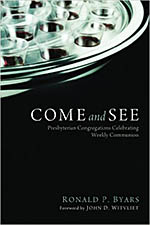Book Review: Come and See: Presbyterian Congregations Celebrating Weekly Communion by Ronald P. Byars
Ronald P. Byars, Come and See: Presbyterian Congregations Celebrating Weekly Communion.
(Eugene, OR: Cascade Books, 2014). 133 pp. $19.

In liturgical and homiletical scholarship, there is continual reflection on the relationship of theology and practice, the so-called lex orandi (law of prayer) and lex credendi (law of belief), and the mutuality of the two. Good theology informs and shapes, hopefully, good practice; good practice confirms good theology, or, sometimes, critiques the theology and corrects it; so does theology to practice, ad infinitum. When it comes to celebration of the Eucharist, many mainline Protestant churches, to which I belong, the tribe called the Presbyterian Church (U.S.A.), and non-denominational churches celebrate the Table once a month, and, ordinarily the first Sunday of the month. Churches in the so-called “high liturgy” traditions celebrate the Table weekly.
In the mid-20th century, the modern ecumenical movement, the modern liturgical renewal movement, the New Homiletic, and the New Hermeneutic surged in tandem one to another. It wasn’t until the latter half of the 20th century when a resurgence in sacramental renewal occurred in mainline churches, due in some quarters to an impulse to bridge the theological and historical divide following Vatican II, coupled with the advent of the digital age and a generation that hungered and thirsted for incarnated presence while navigating the emergence of the world of the “virtual.”
In the Presbyterian Church (U.S.A.), a 1998 overture to our General Assembly sought to clarify the relationship of font and Table as churches faced the pastoral challenge to offer the bread and the cup to non-baptized individuals. The result was a report from a multi-year study entitled, “Invitation to Christ,” which I had the privilege to assist in writing. The study described the longstanding theology and practice of sequencing font before table, font as invitation into the life of Christ and the Lord’s body, with the Table as the continuing nourishment of the body of baptized believers. The study prescribed five sacramental practices, including more frequent communion, or the gradual movement towards increased frequency by simply placing the chalice and paten in plain view of the gathered assembly juxtaposed to a water-filled font. In short, the hope was to get the Church to think about and to think through its theological traditions, or to comb the theology through engaging in the practices, or to enact the theology in the practice, or, still yet, to consider the theological justification and grammar of the practices themselves.
Ronald Byars, Presbyterian liturgical scholar who previously taught at Union Presbyterian Seminary in Richmond, Virginia, gives us in this present volume a treasure and an invitation. It’s a treasure because as a pastor-professor-theologian, Byars is adept at describing the theology and history of the Lord’s Table, specifically, and sacramental theology, more generally. Even as he belongs to the Presbyterian tribe, he and his writing are ecumenical through and through. But he doesn’t stop with the history and the theology; here’s the best part – he presents actual case studies of pastoral leaders and their congregational communities in living into and living out frequent Eucharistic celebration, including myself who happens to be one of the pastors he interviewed while serving as solo pastor in New Jersey concurrent to serving as Moderator of the General Assembly of the Presbyterian Church (U.S.A.)
Byars shared pastor interviews which detailed each pastor’s background, community analysis, and an account of factors leading them and their community to engage in frequent communion. He described the challenges encountered, how each community navigated through those challenges theologically, practically, and ecclesiastically, and what they learned about themselves as a community, individually, and about the sacraments. In short, Byars’s volume is an accessible theo-praxis, combining the best of theology, history, and ethnography in a reader-friendly book that connects actual pastoral practice with the richness of theology, and vice versa.
Although the writer and the book itself come from the Presbyterian theological tradition, the ecumenical orientation of both messenger and message provide great value to all Christian traditions, pastors, preachers, seminarians, and all who seek to take both theology on the one hand, seriously, and practice on the other, and put the two into mutual conversation.


